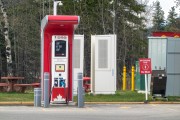Toronto experienced something unusual this month: the opening of a new rapid transit service. The Union-Pearson Express is now up and running, and although it’s not a commuter transit service, it was a priority project in the first wave of the Big Move transit plan.
And that’s not the only sign of transit progress. Boring machines are currently tunnelling for the Eglinton Crosstown, which will be Toronto’s first new rapid transit line since the Sheppard subway. The region has also seen a flurry of transit funding announcements, from light rail for Hamilton, Mississauga and Brampton to planned improvements to the GO train network.
Those new investments are part of the province’s "Moving Ontario Forward" plan, a long-overdue injection of $16 billion into transit infrastructure and service. However, getting a healthy return on these investments depends on having the right density around them.
Why density matters
Density plays a key role in driving ridership: the more people there are close to a station, the more of them will use the service. When a transit corridor is built without the appropriate level of density, it causes three problems.
First, it’s an inefficient use of public infrastructure dollars. Given how few of those dollars we have, it makes sense to prioritize the projects that will serve the most people and do the most to relieve congestion.
Second, low-density lines and stations create a financial drag on our transit systems. Those lines still have significant operating costs. Without the ridership levels to pay for them, they will have to be subsidized by fares collected from other parts of the system.
And finally, this approach squanders the opportunity to build thousands of homes and businesses with access to rapid transit. Homebuyers are finding it increasingly difficult to purchase homes where they want to live — in walkable, transit-friendly neighbourhoods. Given the shortage of those homes at an affordable price, maximizing development along transit lines should be a key planning policy goal.
That third problem has long-term implications. The Greater Toronto Area (GTA) is adding roughly 100,00 residents people every year, and its population is projected to reach 9.4 million by 2041. Those people will need homes and workplaces, along with a transportation network to get around. That growth also needs to be accommodated while protecting the region’s Greenbelt, farmland and drinking water. In short, we can’t afford to squander prime development opportunities around transit.
The regional density deficit
And yet, the GTA’s existing rapid transit corridors are under-developed, under-zoned and under-utilized. The population and employment densities around most rapid transit stations are so low, they fall short of the thresholds identified by Metrolinx to support higher-order transit.
The table below summarizes the current density levels around major rapid transit stations, looking specifically at the number of jobs and people within 800 metres, and compares them to Metrolinx’s recommendations.

For every transit mode, our region is falling short. For example, only 31 per cent of our subway station areas achieve the density level (a minimum of 250 residents and jobs per hectare) identified by Metrolinx to make a subway viable:

The density shortfall is a severe enough problem for existing transit, but it’s even more concerning for upcoming projects. As it stands, Ontario is investing in transit corridors that don’t yet meet its own guidelines for success.
A chance to change tracks
Fortunately Ontario has a once-in-a-decade opportunity to fix all of this. The province is in the midst of a coordinated review of its land-use planning legislation. The Pembina Institute submitted detailed recommendations for that review, which highlight two solutions to the current problem.
The first solution is to set density targets for the areas around transit corridors and stations. The Growth Plan for the Greater Golden Horseshoe already establishes targets that direct growth. Their purpose is to guide municipalities, so they build up in urban centres rather than continually sprawling outward.
It makes sense to improve the current targets as part of the review, but also to expand them to cover transit areas in full. That will give municipalities and developers clear guidance about where they should be building in order to align with transportation infrastructure.
The second solution is to make provincial funding for transit contingent on the right development patterns. If the province is going to invest billions of dollars into building rapid transit lines, the municipality receiving the infrastructure should also have to make a commitment. Investment in a project shouldn’t happen unless the appropriate density exists nearby, or the municipality has a credible plan to create it. Surprising as it may seem, that’s not the case right now. Metrolinx has published guidelines, but they aren’t being translated into action.
The investments being made in rapid transit across the GTA and in Hamilton are good news. But if we’re going to avoid bad news stories down the road — be it underused transit lines, inadequate fare revenues or a lack of affordable options for homebuyers — new transit and increased density must go hand-in-hand.







